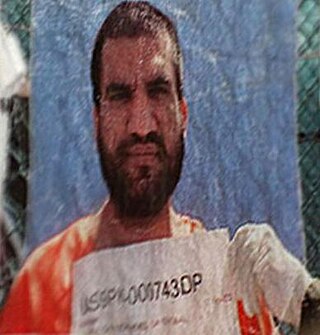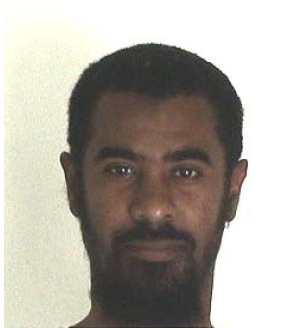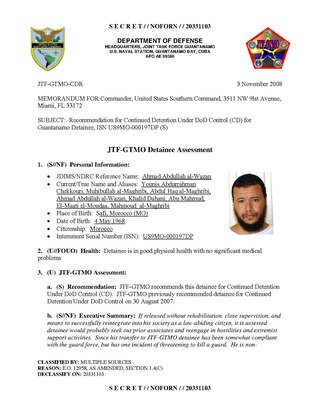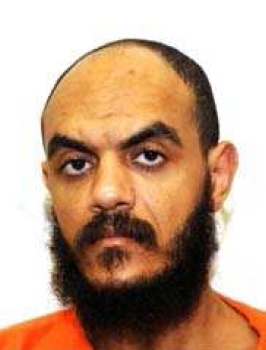Extrajudicial prisoners of the United States, in the context of the early twenty-first century War on Terrorism, refers to foreign nationals the United States detains outside of the legal process required within United States legal jurisdiction. In this context, the U.S. government is maintaining torture centers, called black sites, operated by both known and secret intelligence agencies. Such black sites were later confirmed by reports from journalists, investigations, and from men who had been imprisoned and tortured there, and later released after being tortured until the CIA was comfortable they had done nothing wrong, and had nothing to hide.

Musab Omar Ali Al Mudwani is a citizen of Yemen who was held in extrajudicial detention in the United States Guantanamo Bay detainment camps, in Cuba.

Muhammad Saad Iqbal is a Pakistani citizen who was held in extrajudicial detention in the United States Guantanamo Bay detention camps, in Cuba. Madni's Guantanamo Internment Serial Number was 743. The Department of Defense reports that he was born on October 17, 1977.

Sulaiman Awath Sulaiman Bin Ageel Al Nahdi is a citizen of Yemen, who held in extrajudicial detention in the United States Guantanamo Bay detainment camps, in Cuba, from May 5, 2002, until November 16, 2015. Al Nahdi's Guantanamo Internment Serial Number is 511. The Department of Defense reports that al Nahdi was born on December 1, 1974, in Mukalla, Yemen.

Omar Hamzayavich Abdulayev, also known as Muhammadi Davlatov, is a citizen of Tajikistan who was held in extrajudicial detention in the United States's Guantanamo Bay detention camps in Cuba. He arrived at Guantanamo on February 9, 2002.

Ghaleb Nassar Al Bihani is a citizen of Yemen formerly held in the United States Guantanamo Bay detainment camps, in Cuba. The Department of Defense estimate that he was born in 1979, in Tabuk, Saudi Arabia.

Yunis Abdurrahman Shokuri is a citizen of Morocco who was held in extrajudicial detention in the Guantanamo Bay detention camps, in Cuba. The Department of Defense reports his date of birth as May 4, 1968. The Department of Defense reports that he was born in Safi, Morocco.

Ridah Bin Saleh Bin Mabrouk Al Yazidi is a citizen of Tunisia who was held in extrajudicial detention in the United States Guantanamo Bay detainment camps, in Cuba since the day it opened, on January 11, 2002.

Ibrahim Othman Ibrahim Idris was a citizen of Sudan, formerly held in extrajudicial detention in the United States' Guantanamo Bay detainment camps, in Cuba. His detainee ID number was 036.

Tarek Ali Abdullah Ahmed Baada is a citizen of Yemen, who was formerly held in extrajudicial detention in the United States Guantanamo Bay detainment camps, in Cuba. His detainee ID number is 178. Joint Task Force Guantanamo counter-terrorism analysts estimated that Baada was born in 1978 in Shebwa, Yemen.
Adil Hadi al Jazairi Bin Hamlili is a citizen of Algeria who was held in extrajudicial detention in the United States Guantanamo Bay detainment camps, in Cuba. The US Department of Defense reports that Bin Hamlili was born on 26 June 1976, in Oram (Oran) [sic] Algeria. His Guantanamo Internment Serial Number was 1452.
Nasir Maziyad Abdallah Al Qurayshi Al Subii is a citizen of Saudi Arabia who was held in extrajudicial detention in the United States Guantanamo Bay detention camps, in Cuba. His Guantanamo Internment Serial Number was 497. American counter-terror analysts estimate he was born in 1983, in Al Arib, Saudi Arabia.
In United States law, habeas corpus is a recourse challenging the reasons or conditions of a person's detention under color of law. The Guantanamo Bay detention camp is a United States military prison located within Guantanamo Bay Naval Base. A persistent standard of indefinite detention without trial and incidents of torture led the operations of the Guantanamo Bay detention camp to be challenged internationally as an affront to international human rights, and challenged domestically as a violation of the Due Process Clause of the Fifth and Fourteenth amendments of the United States Constitution, including the right of petition for habeas corpus. On 19 February 2002, Guantanamo detainees petitioned in federal court for a writ of habeas corpus to review the legality of their detention.

Abdul Rahman Shalabi is a citizen of Saudi Arabia held in extrajudicial detention in the United States Guantanamo Bay detention camps, in Cuba. His Guantanamo Internee Security Number is 42.
Kiyemba v. Bush (Civil Action No. 05-cv-01509) is a petition for habeas corpus filed on behalf of Jamal Kiyemba, a Ugandan citizen formerly held in extrajudicial detention in the United States' Guantanamo Bay detention camps, in Cuba. Mr. Kiyemba is the next friend of each of the nine Uighur petitioners, Abdusabur, Abdusamad, Abdunasir, Hammad, Hudhaifa, Jalaal, Khalid, Saabir, and Saadiq, who seek the writ of habeas corpus through the petition

Al Halmandy v. Bush, No. 1:05-cv-02385, is a writ of habeas corpus filed on behalf of 63 Guantanamo detainees, on December 13, 2005. It was one of over 200 habeas corpus petitions filed on behalf of detainees held in the Guantanamo Bay detention camp in Cuba.

Civil Action No. 02-cv-0299 is a habeas corpus petition submitted on behalf of several Guantanamo captives.
El Mashad v. Bush is a writ of habeas corpus filed on behalf of several Guantanamo detainees, including Sherif el-Mashad, Adel Fattouh Aly Ahmed Algazzar and Alladeen.
Al Joudi v. Bush (Civil Action No. 05-cv-301) is a United States District Court for the District of Columbia case. On February 9, 2005, a Petition for a Writ of Habeas Corpus was filed on behalf of four Guantanamo detainees: Majid Abdulla Al Joudi, Yousif Mohammad Mubarak Al-Shehri, Abdulla Mohammad Al Ghanmi and Abdul-Hakim Abdul-Rahman Al-Moosa, before US District Court Judge Gladys Kessler. It was one of over 200 habeas corpus petitions filed in the US District Court on behalf of detainees held in the Guantanamo Bay detention camp in Cuba, seeking release. On March 26, 2008, Judge Gladys Kessler dismissed the petition as moot.
Rafiq Bin Bashir Bin Jalud al Hami is a citizen of Tunisia, who was formerly held for over seven years without charge or trial in the United States's Guantanamo Bay detention camps, in Cuba. His Guantanamo Internment Serial Number was 892. The Department of Defense reports that he was born on 14 March 1969, in Tunisia.











